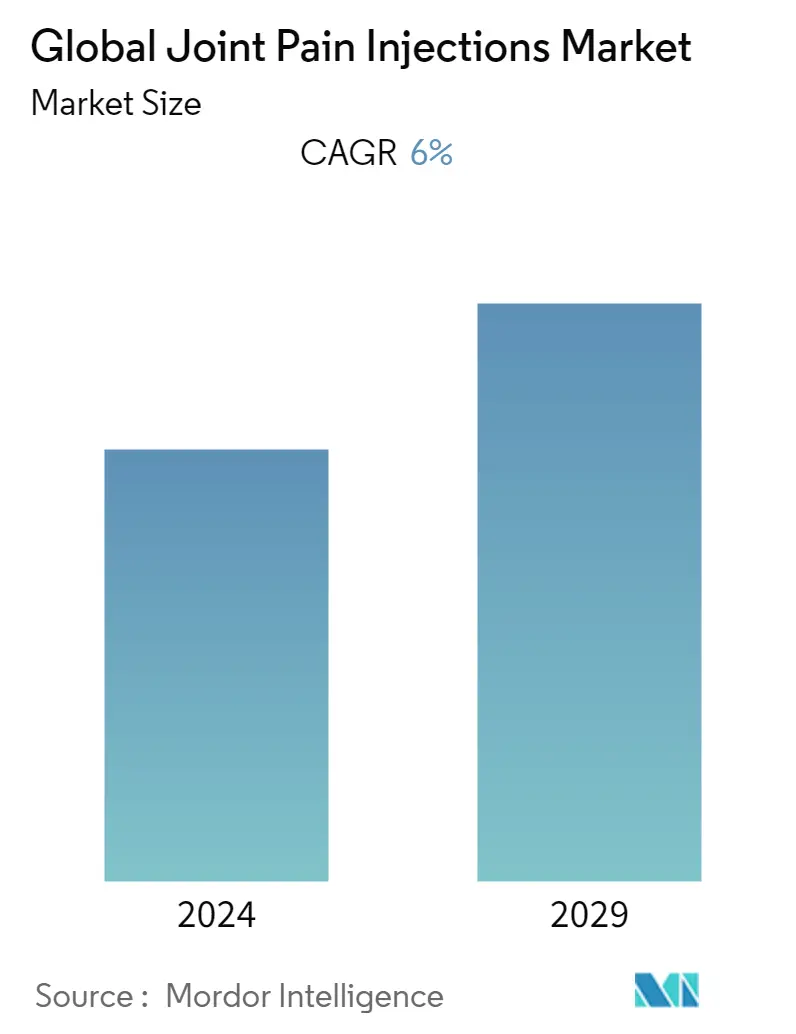Market Size of Global Joint Pain Injections Industry

| Study Period | 2019 - 2029 |
| Base Year For Estimation | 2023 |
| Forecast Data Period | 2024 - 2029 |
| CAGR | 6.00 % |
| Fastest Growing Market | Asia Pacific |
| Largest Market | North America |
Major Players
*Disclaimer: Major Players sorted in no particular order |
Joint Pain Injections Market Analysis
Joint Pain Injections Market is expected to register a growth at a CAGR of 6% over the forecast period.
The COVID-19 pandemic restrictions affected the diagnosis and treatment of chronic diseases worldwide impacting the studied market. For instance, according to a research article titled "COVID-19 and Rheumatoid Arthritis" published in May 2021, older patients with rheumatoid arthritis (RA) were susceptible to COVID-19. RA patients had been affected by changes in access to care, telemedicine, drug shortages, anxiety, and social isolation, which contribute to disease flares. During the pandemic, access to therapy was constrained. 42% of patients reported canceled/postponed appointments and switched to telemedicine visits. Hence, COVID-19 had an adverse impact on the joint pain infection market.
In addition, the growing prevalence of arthritis and increasing geriatric population worldwide, and the increasing demand for knee pain injections are actively affecting the growth of the studied market.
According to World Population Prospects 2022 report, the percentage of the population aged 65 years and over in Sub-Saharan Africa is 3.0 in 2022 and projected to be 3.3 in 2030, in Northern Africa and Western Asia it is estimated to be 5.5 in 2022 and projected to be 7.0 in 2030, in Central and Southern Asia it is estimated to be 6.4 in 2022 and projected to be 8.1 in 2030, and in Europe and Northern America, 18.7 in 2022 and projected to be 22.0 in 2030. Since arthritis is more common in the geriatric population, the growth of the market segment is likely to increase as this population increases.
Furthermore, as per the Centers for Disease Control and Prevention's October 2021 update, 43% of osteoarthritis patients were 65 years of age or older in 2020. It also stated that the annual incidence of knee osteoarthritis is highest between 55 and 64 years old. More than half of individuals with symptomatic knee osteoarthritis are younger than 65. The surge in the geriatric population is expected to increase the burden of osteoarthritis and other disorders which is likely to augment the growth of the studied market over the forecast period.
Therefore, owing to the aforementioned factors the studied market is anticipated to witness growth over the analysis period. however, the high costs of the injections and reimbursement issues are likely to impede the market growth.
Joint Pain Injections Industry Segmentation
As per the scope of the report, joint pain injections are products that can be injected directly into the knee joint or any joints in the body to relieve pain and inflammation quickly. For patients who have inadequate responses or contraindications to systemic anti-inflammatory or analgesic drugs, joint pain injections are preferred. The Joint Pain Injections Market is segmented by Type of Injection (Steroid Joint Injections, Hyaluronic Acid Injections, Platelet-rich Plasma (PRP) Injections, Placental Tissue Matrix (PTM) Injections, and Others), Application (Shoulder & Elbow, Knee & Ankle, Spinal Joints, Hip Joint, and Others), and Geography (North America, Europe, Asia-Pacific, Middle East and Africa, and South America). The market report also covers the estimated market sizes and trends for 17 different countries across major regions, globally. The report offers the value (in USD million) for the above segments.
| Type of Injection | |
| Steroid Joint Injections | |
| Hyaluronic Acid Injections | |
| Platelet-rich Plasma (PRP) Injections | |
| Placental Tissue Matrix (PTM) Injections | |
| Others |
| Applications | |
| Shoulder & Elbow | |
| Knee & Ankle | |
| Spinal Joints | |
| Hip Joint | |
| Others |
| Geography | ||||||||
| ||||||||
| ||||||||
| ||||||||
| ||||||||
|
Global Joint Pain Injections Market Size Summary
The joint pain injections market is poised for significant growth, driven by the increasing prevalence of arthritis and a rising geriatric population globally. The market experienced disruptions due to the COVID-19 pandemic, which affected access to care and treatment for chronic diseases, including joint pain conditions. Despite these challenges, the demand for knee pain injections is on the rise, particularly as arthritis is more common among older adults. The market is further bolstered by the popularity of hyaluronic acid injections as a non-surgical treatment option for osteoarthritis-related knee pain, especially among patients who have not found relief with other therapies. The development and launch of novel products by key market players are expected to enhance market growth during the forecast period.
North America is anticipated to lead the joint pain injections market, supported by a high prevalence of musculoskeletal disorders, a growing elderly population, and a robust healthcare infrastructure. The region benefits from a strong presence of industry players and a high adoption rate of advanced medical technologies. The increasing number of older adults in North America is likely to drive demand for joint pain injections, further propelling market expansion. The competitive landscape of the market is fragmented, with numerous global and regional companies, including prominent players like Anika Therapeutics, Zimmer Biomet, and Bioventus LLC, contributing to the market dynamics. These companies are actively engaged in research and development, aiming to improve treatment options and enhance the quality of life for individuals with chronic joint pain.
Global Joint Pain Injections Market Size - Table of Contents
-
1. MARKET DYNAMICS
-
1.1 Market Overview
-
1.2 Market Drivers
-
1.2.1 Growing Prevalence of Arthritis and Increasing Geriatric Population Worldwide
-
1.2.2 Increasing Demand for Knee Pain Injections
-
-
1.3 Market Restraints
-
1.3.1 High Costs of the Injections
-
1.3.2 Reimbursement Issues
-
-
1.4 Porter's Five Force Analysis
-
1.4.1 Threat of New Entrants
-
1.4.2 Bargaining Power of Buyers/Consumers
-
1.4.3 Bargaining Power of Suppliers
-
1.4.4 Threat of Substitute Products
-
1.4.5 Intensity of Competitive Rivalry
-
-
-
2. MARKET SEGMENTATION (Market Size by Value - USD million)
-
2.1 Type of Injection
-
2.1.1 Steroid Joint Injections
-
2.1.2 Hyaluronic Acid Injections
-
2.1.3 Platelet-rich Plasma (PRP) Injections
-
2.1.4 Placental Tissue Matrix (PTM) Injections
-
2.1.5 Others
-
-
2.2 Applications
-
2.2.1 Shoulder & Elbow
-
2.2.2 Knee & Ankle
-
2.2.3 Spinal Joints
-
2.2.4 Hip Joint
-
2.2.5 Others
-
-
2.3 Geography
-
2.3.1 North America
-
2.3.1.1 United States
-
2.3.1.2 Canada
-
2.3.1.3 Mexico
-
-
2.3.2 Europe
-
2.3.2.1 Germany
-
2.3.2.2 United Kingdom
-
2.3.2.3 France
-
2.3.2.4 Italy
-
2.3.2.5 Spain
-
2.3.2.6 Rest of Europe
-
-
2.3.3 Asia-Pacific
-
2.3.3.1 China
-
2.3.3.2 Japan
-
2.3.3.3 India
-
2.3.3.4 Australia
-
2.3.3.5 South Korea
-
2.3.3.6 Rest of Asia-Pacific
-
-
2.3.4 Middle-East and Africa
-
2.3.4.1 GCC
-
2.3.4.2 South Africa
-
2.3.4.3 Rest of Middle-East and Africa
-
-
2.3.5 South America
-
2.3.5.1 Brazil
-
2.3.5.2 Argentina
-
2.3.5.3 Rest of South America
-
-
-
Global Joint Pain Injections Market Size FAQs
What is the current Global Joint Pain Injections Market size?
The Global Joint Pain Injections Market is projected to register a CAGR of 6% during the forecast period (2024-2029)
Who are the key players in Global Joint Pain Injections Market?
Zimmer Biomet, Anika Therapeutics, Inc., Bioventus LLC, Ferring B.V. and sanofi-aventis LLC are the major companies operating in the Global Joint Pain Injections Market.

